Factors and Interventions: Childhood Obesity in Indigenous Australians
VerifiedAdded on 2023/01/11
|8
|2163
|24
Report
AI Summary
This report investigates the issue of childhood obesity and its disproportionate impact on Indigenous Australians, highlighting the healthcare inequalities they face. It identifies racial discrimination and socioeconomic factors like poverty and lack of education as primary drivers of this disparity. The report then examines a primary healthcare intervention focusing on pre-conception and antenatal care, emphasizing its potential to reduce obesity risks across generations. Furthermore, it underscores the significance of cultural knowledge and sensitivity in healthcare delivery, illustrating how these factors can significantly affect access to primary care services for Indigenous communities. The analysis includes real-world examples and relevant references to support the arguments, offering insights into effective strategies for addressing this critical public health challenge and improving health outcomes.
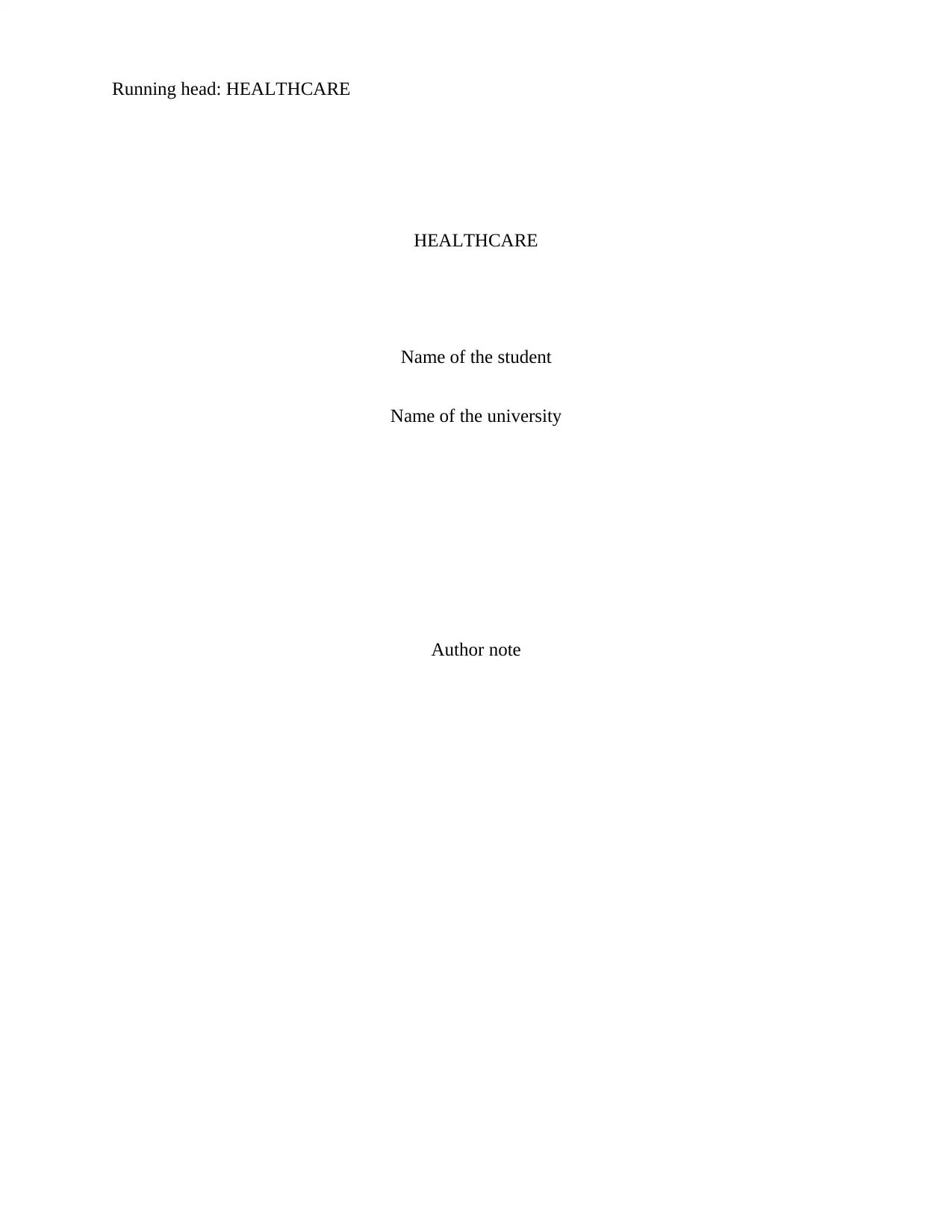
Running head: HEALTHCARE
HEALTHCARE
Name of the student
Name of the university
Author note
HEALTHCARE
Name of the student
Name of the university
Author note
Paraphrase This Document
Need a fresh take? Get an instant paraphrase of this document with our AI Paraphraser
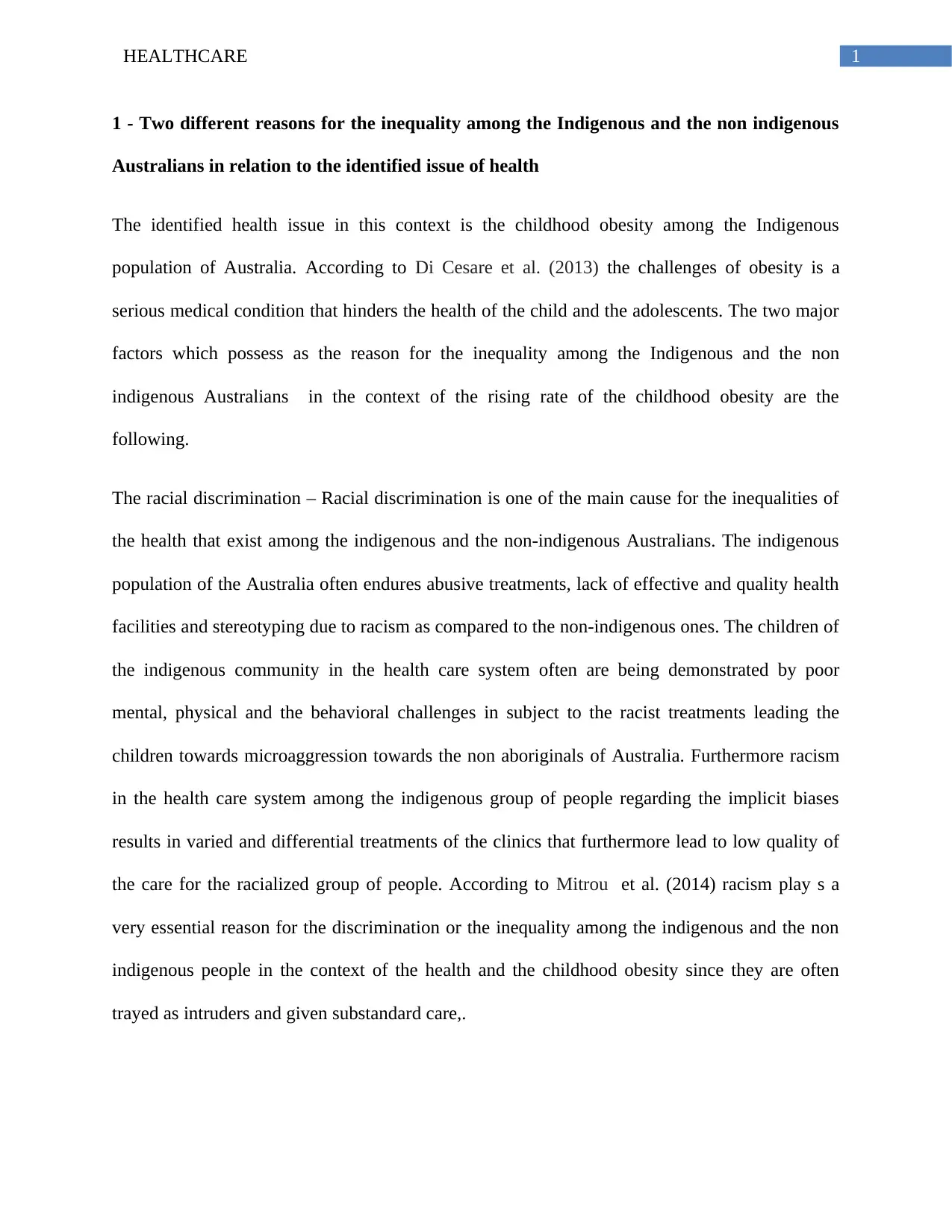
HEALTHCARE 1
1 - Two different reasons for the inequality among the Indigenous and the non indigenous
Australians in relation to the identified issue of health
The identified health issue in this context is the childhood obesity among the Indigenous
population of Australia. According to Di Cesare et al. (2013) the challenges of obesity is a
serious medical condition that hinders the health of the child and the adolescents. The two major
factors which possess as the reason for the inequality among the Indigenous and the non
indigenous Australians in the context of the rising rate of the childhood obesity are the
following.
The racial discrimination – Racial discrimination is one of the main cause for the inequalities of
the health that exist among the indigenous and the non-indigenous Australians. The indigenous
population of the Australia often endures abusive treatments, lack of effective and quality health
facilities and stereotyping due to racism as compared to the non-indigenous ones. The children of
the indigenous community in the health care system often are being demonstrated by poor
mental, physical and the behavioral challenges in subject to the racist treatments leading the
children towards microaggression towards the non aboriginals of Australia. Furthermore racism
in the health care system among the indigenous group of people regarding the implicit biases
results in varied and differential treatments of the clinics that furthermore lead to low quality of
the care for the racialized group of people. According to Mitrou et al. (2014) racism play s a
very essential reason for the discrimination or the inequality among the indigenous and the non
indigenous people in the context of the health and the childhood obesity since they are often
trayed as intruders and given substandard care,.
1 - Two different reasons for the inequality among the Indigenous and the non indigenous
Australians in relation to the identified issue of health
The identified health issue in this context is the childhood obesity among the Indigenous
population of Australia. According to Di Cesare et al. (2013) the challenges of obesity is a
serious medical condition that hinders the health of the child and the adolescents. The two major
factors which possess as the reason for the inequality among the Indigenous and the non
indigenous Australians in the context of the rising rate of the childhood obesity are the
following.
The racial discrimination – Racial discrimination is one of the main cause for the inequalities of
the health that exist among the indigenous and the non-indigenous Australians. The indigenous
population of the Australia often endures abusive treatments, lack of effective and quality health
facilities and stereotyping due to racism as compared to the non-indigenous ones. The children of
the indigenous community in the health care system often are being demonstrated by poor
mental, physical and the behavioral challenges in subject to the racist treatments leading the
children towards microaggression towards the non aboriginals of Australia. Furthermore racism
in the health care system among the indigenous group of people regarding the implicit biases
results in varied and differential treatments of the clinics that furthermore lead to low quality of
the care for the racialized group of people. According to Mitrou et al. (2014) racism play s a
very essential reason for the discrimination or the inequality among the indigenous and the non
indigenous people in the context of the health and the childhood obesity since they are often
trayed as intruders and given substandard care,.
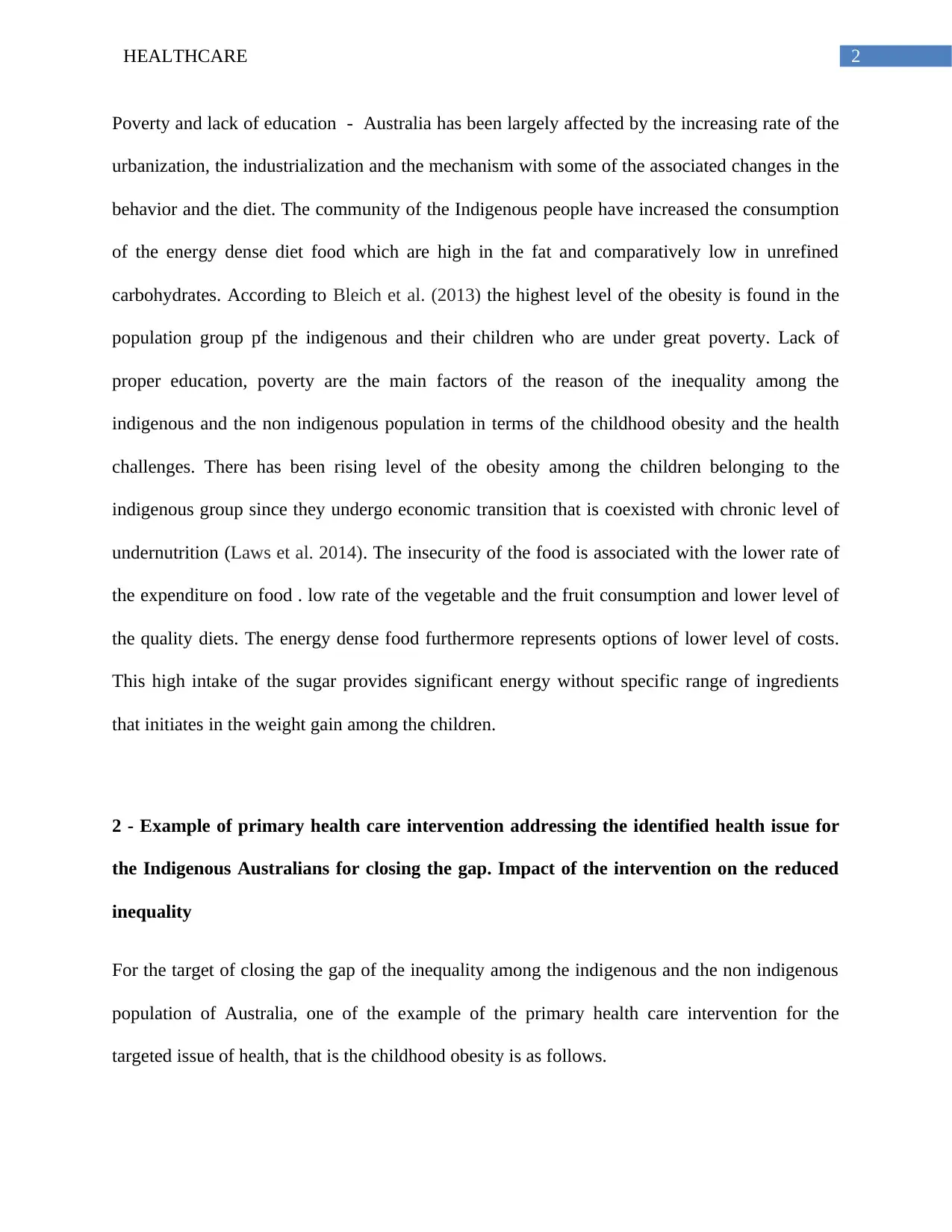
2HEALTHCARE
Poverty and lack of education - Australia has been largely affected by the increasing rate of the
urbanization, the industrialization and the mechanism with some of the associated changes in the
behavior and the diet. The community of the Indigenous people have increased the consumption
of the energy dense diet food which are high in the fat and comparatively low in unrefined
carbohydrates. According to Bleich et al. (2013) the highest level of the obesity is found in the
population group pf the indigenous and their children who are under great poverty. Lack of
proper education, poverty are the main factors of the reason of the inequality among the
indigenous and the non indigenous population in terms of the childhood obesity and the health
challenges. There has been rising level of the obesity among the children belonging to the
indigenous group since they undergo economic transition that is coexisted with chronic level of
undernutrition (Laws et al. 2014). The insecurity of the food is associated with the lower rate of
the expenditure on food . low rate of the vegetable and the fruit consumption and lower level of
the quality diets. The energy dense food furthermore represents options of lower level of costs.
This high intake of the sugar provides significant energy without specific range of ingredients
that initiates in the weight gain among the children.
2 - Example of primary health care intervention addressing the identified health issue for
the Indigenous Australians for closing the gap. Impact of the intervention on the reduced
inequality
For the target of closing the gap of the inequality among the indigenous and the non indigenous
population of Australia, one of the example of the primary health care intervention for the
targeted issue of health, that is the childhood obesity is as follows.
Poverty and lack of education - Australia has been largely affected by the increasing rate of the
urbanization, the industrialization and the mechanism with some of the associated changes in the
behavior and the diet. The community of the Indigenous people have increased the consumption
of the energy dense diet food which are high in the fat and comparatively low in unrefined
carbohydrates. According to Bleich et al. (2013) the highest level of the obesity is found in the
population group pf the indigenous and their children who are under great poverty. Lack of
proper education, poverty are the main factors of the reason of the inequality among the
indigenous and the non indigenous population in terms of the childhood obesity and the health
challenges. There has been rising level of the obesity among the children belonging to the
indigenous group since they undergo economic transition that is coexisted with chronic level of
undernutrition (Laws et al. 2014). The insecurity of the food is associated with the lower rate of
the expenditure on food . low rate of the vegetable and the fruit consumption and lower level of
the quality diets. The energy dense food furthermore represents options of lower level of costs.
This high intake of the sugar provides significant energy without specific range of ingredients
that initiates in the weight gain among the children.
2 - Example of primary health care intervention addressing the identified health issue for
the Indigenous Australians for closing the gap. Impact of the intervention on the reduced
inequality
For the target of closing the gap of the inequality among the indigenous and the non indigenous
population of Australia, one of the example of the primary health care intervention for the
targeted issue of health, that is the childhood obesity is as follows.
⊘ This is a preview!⊘
Do you want full access?
Subscribe today to unlock all pages.

Trusted by 1+ million students worldwide
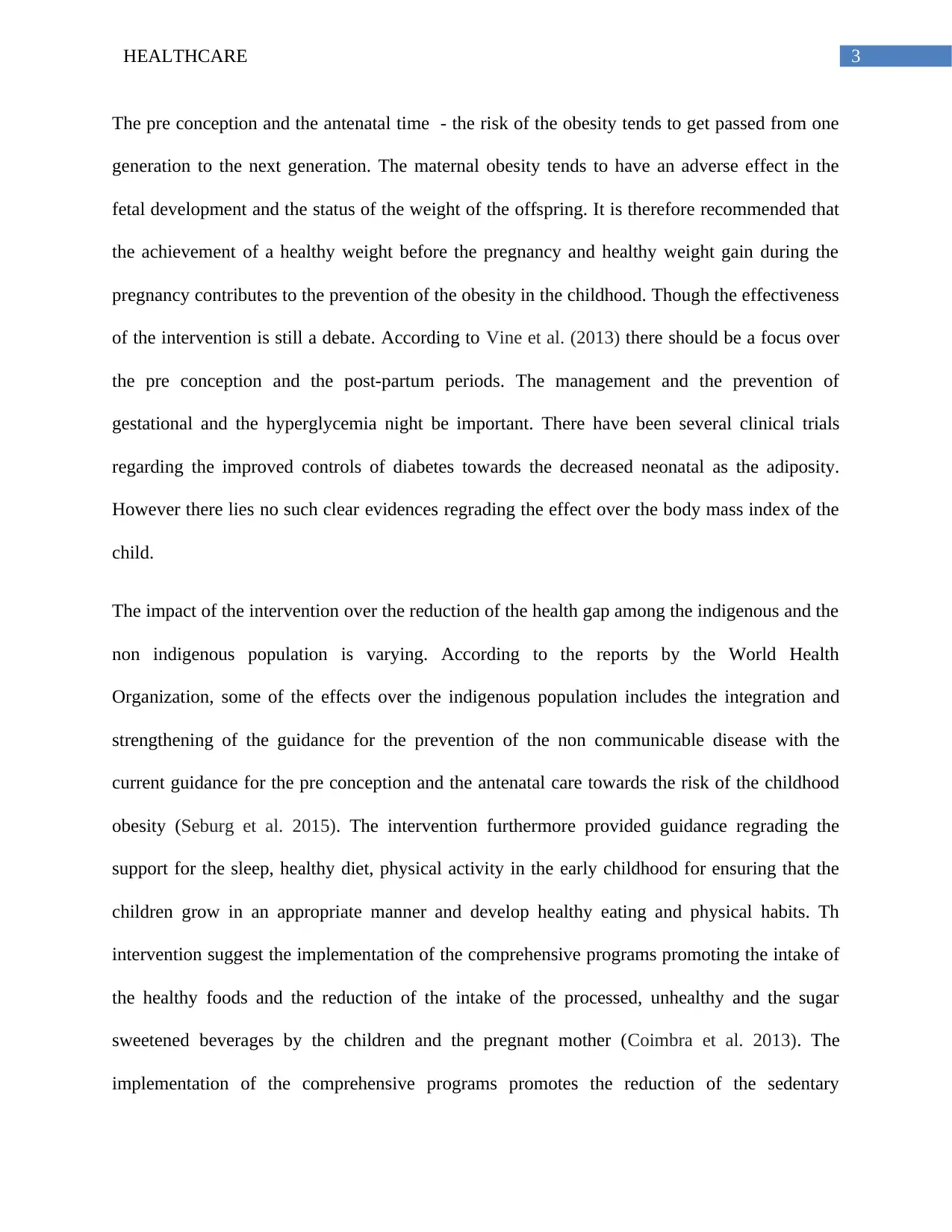
3HEALTHCARE
The pre conception and the antenatal time - the risk of the obesity tends to get passed from one
generation to the next generation. The maternal obesity tends to have an adverse effect in the
fetal development and the status of the weight of the offspring. It is therefore recommended that
the achievement of a healthy weight before the pregnancy and healthy weight gain during the
pregnancy contributes to the prevention of the obesity in the childhood. Though the effectiveness
of the intervention is still a debate. According to Vine et al. (2013) there should be a focus over
the pre conception and the post-partum periods. The management and the prevention of
gestational and the hyperglycemia night be important. There have been several clinical trials
regarding the improved controls of diabetes towards the decreased neonatal as the adiposity.
However there lies no such clear evidences regrading the effect over the body mass index of the
child.
The impact of the intervention over the reduction of the health gap among the indigenous and the
non indigenous population is varying. According to the reports by the World Health
Organization, some of the effects over the indigenous population includes the integration and
strengthening of the guidance for the prevention of the non communicable disease with the
current guidance for the pre conception and the antenatal care towards the risk of the childhood
obesity (Seburg et al. 2015). The intervention furthermore provided guidance regrading the
support for the sleep, healthy diet, physical activity in the early childhood for ensuring that the
children grow in an appropriate manner and develop healthy eating and physical habits. Th
intervention suggest the implementation of the comprehensive programs promoting the intake of
the healthy foods and the reduction of the intake of the processed, unhealthy and the sugar
sweetened beverages by the children and the pregnant mother (Coimbra et al. 2013). The
implementation of the comprehensive programs promotes the reduction of the sedentary
The pre conception and the antenatal time - the risk of the obesity tends to get passed from one
generation to the next generation. The maternal obesity tends to have an adverse effect in the
fetal development and the status of the weight of the offspring. It is therefore recommended that
the achievement of a healthy weight before the pregnancy and healthy weight gain during the
pregnancy contributes to the prevention of the obesity in the childhood. Though the effectiveness
of the intervention is still a debate. According to Vine et al. (2013) there should be a focus over
the pre conception and the post-partum periods. The management and the prevention of
gestational and the hyperglycemia night be important. There have been several clinical trials
regarding the improved controls of diabetes towards the decreased neonatal as the adiposity.
However there lies no such clear evidences regrading the effect over the body mass index of the
child.
The impact of the intervention over the reduction of the health gap among the indigenous and the
non indigenous population is varying. According to the reports by the World Health
Organization, some of the effects over the indigenous population includes the integration and
strengthening of the guidance for the prevention of the non communicable disease with the
current guidance for the pre conception and the antenatal care towards the risk of the childhood
obesity (Seburg et al. 2015). The intervention furthermore provided guidance regrading the
support for the sleep, healthy diet, physical activity in the early childhood for ensuring that the
children grow in an appropriate manner and develop healthy eating and physical habits. Th
intervention suggest the implementation of the comprehensive programs promoting the intake of
the healthy foods and the reduction of the intake of the processed, unhealthy and the sugar
sweetened beverages by the children and the pregnant mother (Coimbra et al. 2013). The
implementation of the comprehensive programs promotes the reduction of the sedentary
Paraphrase This Document
Need a fresh take? Get an instant paraphrase of this document with our AI Paraphraser
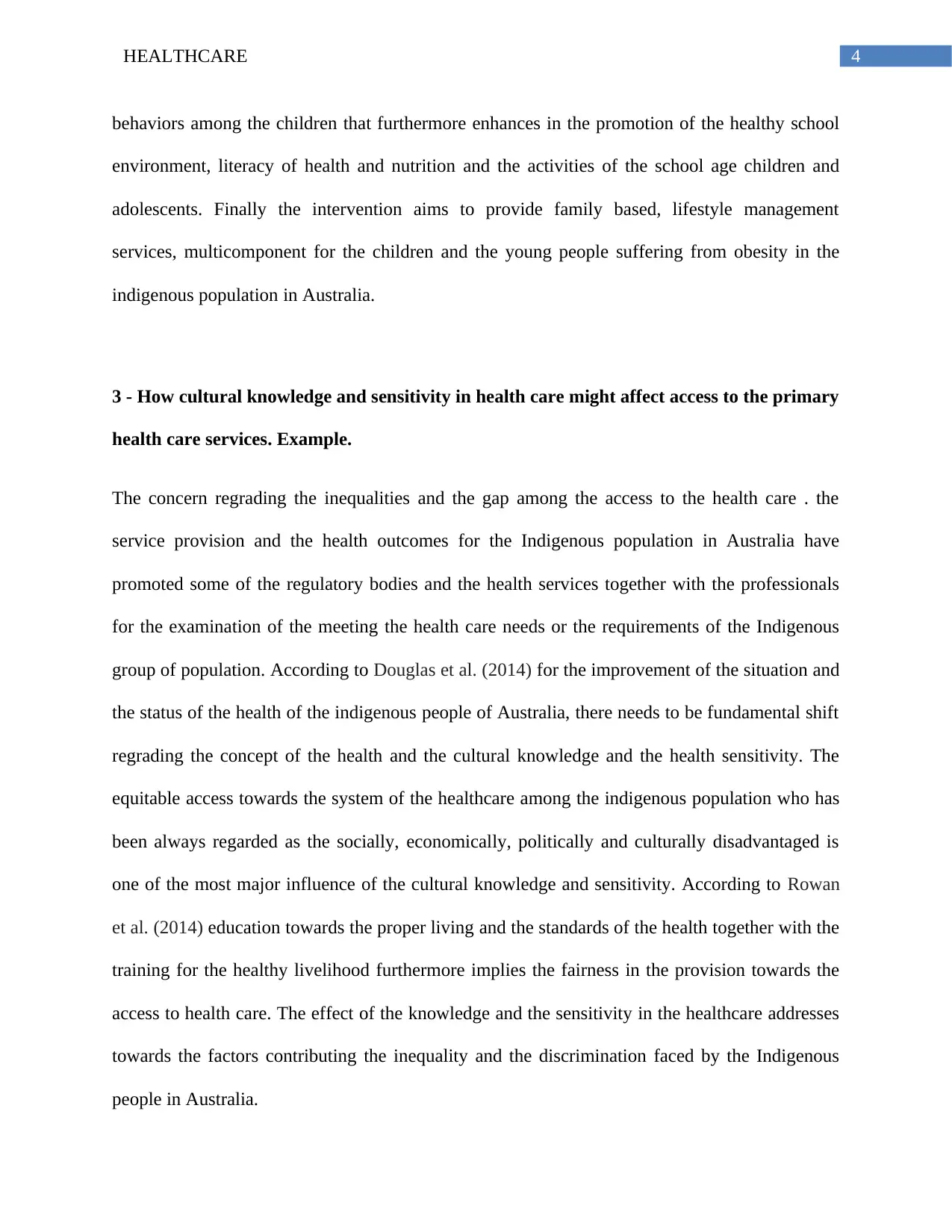
4HEALTHCARE
behaviors among the children that furthermore enhances in the promotion of the healthy school
environment, literacy of health and nutrition and the activities of the school age children and
adolescents. Finally the intervention aims to provide family based, lifestyle management
services, multicomponent for the children and the young people suffering from obesity in the
indigenous population in Australia.
3 - How cultural knowledge and sensitivity in health care might affect access to the primary
health care services. Example.
The concern regrading the inequalities and the gap among the access to the health care . the
service provision and the health outcomes for the Indigenous population in Australia have
promoted some of the regulatory bodies and the health services together with the professionals
for the examination of the meeting the health care needs or the requirements of the Indigenous
group of population. According to Douglas et al. (2014) for the improvement of the situation and
the status of the health of the indigenous people of Australia, there needs to be fundamental shift
regrading the concept of the health and the cultural knowledge and the health sensitivity. The
equitable access towards the system of the healthcare among the indigenous population who has
been always regarded as the socially, economically, politically and culturally disadvantaged is
one of the most major influence of the cultural knowledge and sensitivity. According to Rowan
et al. (2014) education towards the proper living and the standards of the health together with the
training for the healthy livelihood furthermore implies the fairness in the provision towards the
access to health care. The effect of the knowledge and the sensitivity in the healthcare addresses
towards the factors contributing the inequality and the discrimination faced by the Indigenous
people in Australia.
behaviors among the children that furthermore enhances in the promotion of the healthy school
environment, literacy of health and nutrition and the activities of the school age children and
adolescents. Finally the intervention aims to provide family based, lifestyle management
services, multicomponent for the children and the young people suffering from obesity in the
indigenous population in Australia.
3 - How cultural knowledge and sensitivity in health care might affect access to the primary
health care services. Example.
The concern regrading the inequalities and the gap among the access to the health care . the
service provision and the health outcomes for the Indigenous population in Australia have
promoted some of the regulatory bodies and the health services together with the professionals
for the examination of the meeting the health care needs or the requirements of the Indigenous
group of population. According to Douglas et al. (2014) for the improvement of the situation and
the status of the health of the indigenous people of Australia, there needs to be fundamental shift
regrading the concept of the health and the cultural knowledge and the health sensitivity. The
equitable access towards the system of the healthcare among the indigenous population who has
been always regarded as the socially, economically, politically and culturally disadvantaged is
one of the most major influence of the cultural knowledge and sensitivity. According to Rowan
et al. (2014) education towards the proper living and the standards of the health together with the
training for the healthy livelihood furthermore implies the fairness in the provision towards the
access to health care. The effect of the knowledge and the sensitivity in the healthcare addresses
towards the factors contributing the inequality and the discrimination faced by the Indigenous
people in Australia.
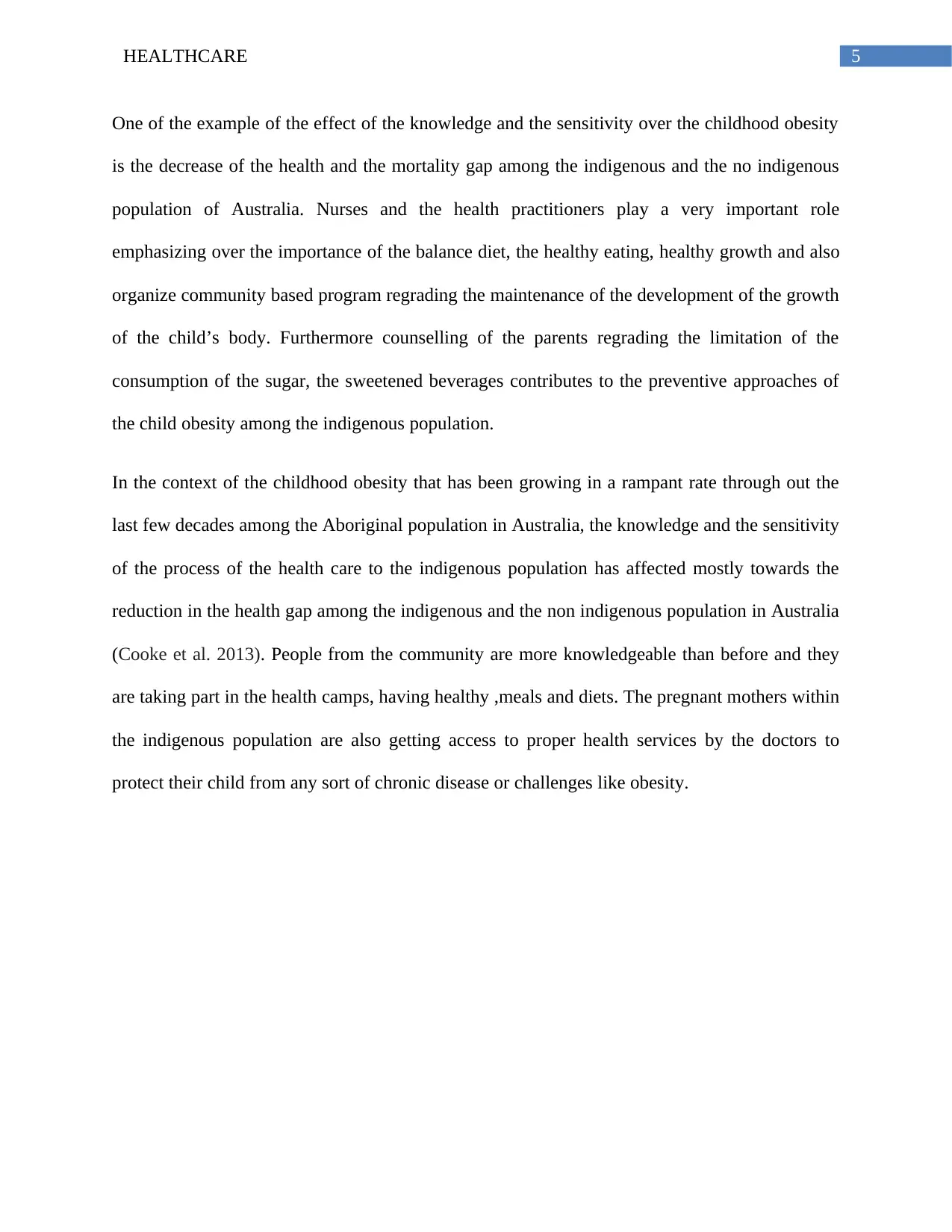
5HEALTHCARE
One of the example of the effect of the knowledge and the sensitivity over the childhood obesity
is the decrease of the health and the mortality gap among the indigenous and the no indigenous
population of Australia. Nurses and the health practitioners play a very important role
emphasizing over the importance of the balance diet, the healthy eating, healthy growth and also
organize community based program regrading the maintenance of the development of the growth
of the child’s body. Furthermore counselling of the parents regrading the limitation of the
consumption of the sugar, the sweetened beverages contributes to the preventive approaches of
the child obesity among the indigenous population.
In the context of the childhood obesity that has been growing in a rampant rate through out the
last few decades among the Aboriginal population in Australia, the knowledge and the sensitivity
of the process of the health care to the indigenous population has affected mostly towards the
reduction in the health gap among the indigenous and the non indigenous population in Australia
(Cooke et al. 2013). People from the community are more knowledgeable than before and they
are taking part in the health camps, having healthy ,meals and diets. The pregnant mothers within
the indigenous population are also getting access to proper health services by the doctors to
protect their child from any sort of chronic disease or challenges like obesity.
One of the example of the effect of the knowledge and the sensitivity over the childhood obesity
is the decrease of the health and the mortality gap among the indigenous and the no indigenous
population of Australia. Nurses and the health practitioners play a very important role
emphasizing over the importance of the balance diet, the healthy eating, healthy growth and also
organize community based program regrading the maintenance of the development of the growth
of the child’s body. Furthermore counselling of the parents regrading the limitation of the
consumption of the sugar, the sweetened beverages contributes to the preventive approaches of
the child obesity among the indigenous population.
In the context of the childhood obesity that has been growing in a rampant rate through out the
last few decades among the Aboriginal population in Australia, the knowledge and the sensitivity
of the process of the health care to the indigenous population has affected mostly towards the
reduction in the health gap among the indigenous and the non indigenous population in Australia
(Cooke et al. 2013). People from the community are more knowledgeable than before and they
are taking part in the health camps, having healthy ,meals and diets. The pregnant mothers within
the indigenous population are also getting access to proper health services by the doctors to
protect their child from any sort of chronic disease or challenges like obesity.
⊘ This is a preview!⊘
Do you want full access?
Subscribe today to unlock all pages.

Trusted by 1+ million students worldwide
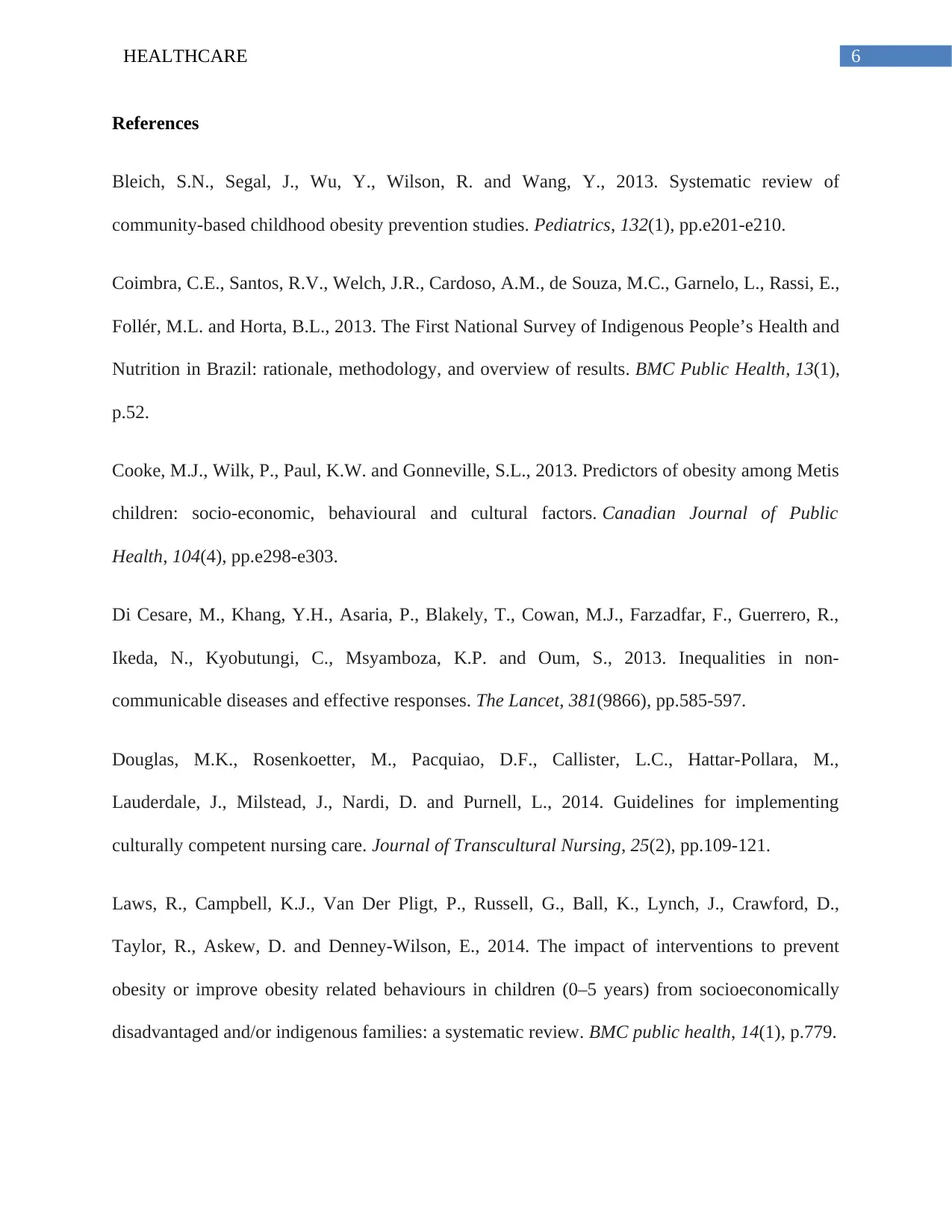
6HEALTHCARE
References
Bleich, S.N., Segal, J., Wu, Y., Wilson, R. and Wang, Y., 2013. Systematic review of
community-based childhood obesity prevention studies. Pediatrics, 132(1), pp.e201-e210.
Coimbra, C.E., Santos, R.V., Welch, J.R., Cardoso, A.M., de Souza, M.C., Garnelo, L., Rassi, E.,
Follér, M.L. and Horta, B.L., 2013. The First National Survey of Indigenous People’s Health and
Nutrition in Brazil: rationale, methodology, and overview of results. BMC Public Health, 13(1),
p.52.
Cooke, M.J., Wilk, P., Paul, K.W. and Gonneville, S.L., 2013. Predictors of obesity among Metis
children: socio-economic, behavioural and cultural factors. Canadian Journal of Public
Health, 104(4), pp.e298-e303.
Di Cesare, M., Khang, Y.H., Asaria, P., Blakely, T., Cowan, M.J., Farzadfar, F., Guerrero, R.,
Ikeda, N., Kyobutungi, C., Msyamboza, K.P. and Oum, S., 2013. Inequalities in non-
communicable diseases and effective responses. The Lancet, 381(9866), pp.585-597.
Douglas, M.K., Rosenkoetter, M., Pacquiao, D.F., Callister, L.C., Hattar-Pollara, M.,
Lauderdale, J., Milstead, J., Nardi, D. and Purnell, L., 2014. Guidelines for implementing
culturally competent nursing care. Journal of Transcultural Nursing, 25(2), pp.109-121.
Laws, R., Campbell, K.J., Van Der Pligt, P., Russell, G., Ball, K., Lynch, J., Crawford, D.,
Taylor, R., Askew, D. and Denney-Wilson, E., 2014. The impact of interventions to prevent
obesity or improve obesity related behaviours in children (0–5 years) from socioeconomically
disadvantaged and/or indigenous families: a systematic review. BMC public health, 14(1), p.779.
References
Bleich, S.N., Segal, J., Wu, Y., Wilson, R. and Wang, Y., 2013. Systematic review of
community-based childhood obesity prevention studies. Pediatrics, 132(1), pp.e201-e210.
Coimbra, C.E., Santos, R.V., Welch, J.R., Cardoso, A.M., de Souza, M.C., Garnelo, L., Rassi, E.,
Follér, M.L. and Horta, B.L., 2013. The First National Survey of Indigenous People’s Health and
Nutrition in Brazil: rationale, methodology, and overview of results. BMC Public Health, 13(1),
p.52.
Cooke, M.J., Wilk, P., Paul, K.W. and Gonneville, S.L., 2013. Predictors of obesity among Metis
children: socio-economic, behavioural and cultural factors. Canadian Journal of Public
Health, 104(4), pp.e298-e303.
Di Cesare, M., Khang, Y.H., Asaria, P., Blakely, T., Cowan, M.J., Farzadfar, F., Guerrero, R.,
Ikeda, N., Kyobutungi, C., Msyamboza, K.P. and Oum, S., 2013. Inequalities in non-
communicable diseases and effective responses. The Lancet, 381(9866), pp.585-597.
Douglas, M.K., Rosenkoetter, M., Pacquiao, D.F., Callister, L.C., Hattar-Pollara, M.,
Lauderdale, J., Milstead, J., Nardi, D. and Purnell, L., 2014. Guidelines for implementing
culturally competent nursing care. Journal of Transcultural Nursing, 25(2), pp.109-121.
Laws, R., Campbell, K.J., Van Der Pligt, P., Russell, G., Ball, K., Lynch, J., Crawford, D.,
Taylor, R., Askew, D. and Denney-Wilson, E., 2014. The impact of interventions to prevent
obesity or improve obesity related behaviours in children (0–5 years) from socioeconomically
disadvantaged and/or indigenous families: a systematic review. BMC public health, 14(1), p.779.
Paraphrase This Document
Need a fresh take? Get an instant paraphrase of this document with our AI Paraphraser
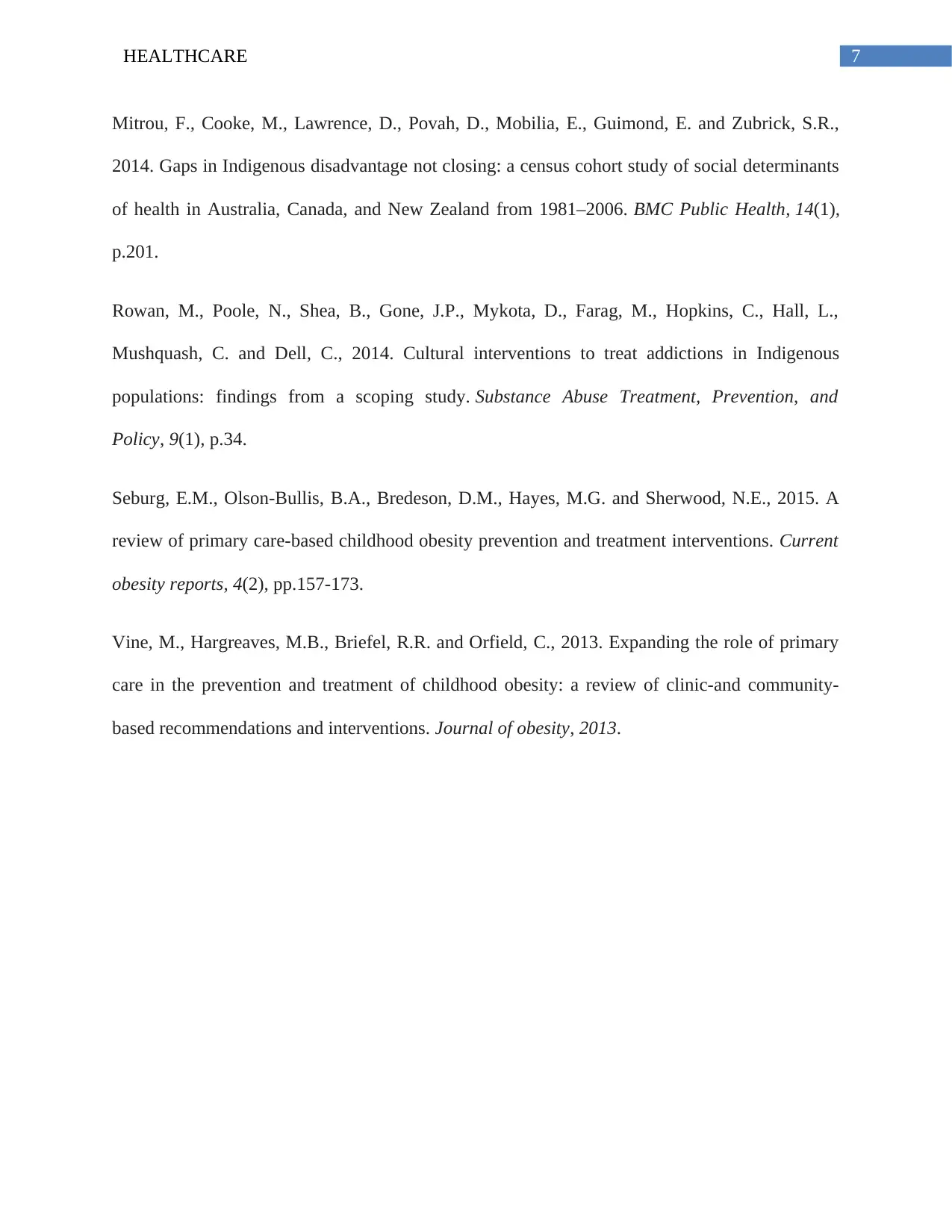
7HEALTHCARE
Mitrou, F., Cooke, M., Lawrence, D., Povah, D., Mobilia, E., Guimond, E. and Zubrick, S.R.,
2014. Gaps in Indigenous disadvantage not closing: a census cohort study of social determinants
of health in Australia, Canada, and New Zealand from 1981–2006. BMC Public Health, 14(1),
p.201.
Rowan, M., Poole, N., Shea, B., Gone, J.P., Mykota, D., Farag, M., Hopkins, C., Hall, L.,
Mushquash, C. and Dell, C., 2014. Cultural interventions to treat addictions in Indigenous
populations: findings from a scoping study. Substance Abuse Treatment, Prevention, and
Policy, 9(1), p.34.
Seburg, E.M., Olson-Bullis, B.A., Bredeson, D.M., Hayes, M.G. and Sherwood, N.E., 2015. A
review of primary care-based childhood obesity prevention and treatment interventions. Current
obesity reports, 4(2), pp.157-173.
Vine, M., Hargreaves, M.B., Briefel, R.R. and Orfield, C., 2013. Expanding the role of primary
care in the prevention and treatment of childhood obesity: a review of clinic-and community-
based recommendations and interventions. Journal of obesity, 2013.
Mitrou, F., Cooke, M., Lawrence, D., Povah, D., Mobilia, E., Guimond, E. and Zubrick, S.R.,
2014. Gaps in Indigenous disadvantage not closing: a census cohort study of social determinants
of health in Australia, Canada, and New Zealand from 1981–2006. BMC Public Health, 14(1),
p.201.
Rowan, M., Poole, N., Shea, B., Gone, J.P., Mykota, D., Farag, M., Hopkins, C., Hall, L.,
Mushquash, C. and Dell, C., 2014. Cultural interventions to treat addictions in Indigenous
populations: findings from a scoping study. Substance Abuse Treatment, Prevention, and
Policy, 9(1), p.34.
Seburg, E.M., Olson-Bullis, B.A., Bredeson, D.M., Hayes, M.G. and Sherwood, N.E., 2015. A
review of primary care-based childhood obesity prevention and treatment interventions. Current
obesity reports, 4(2), pp.157-173.
Vine, M., Hargreaves, M.B., Briefel, R.R. and Orfield, C., 2013. Expanding the role of primary
care in the prevention and treatment of childhood obesity: a review of clinic-and community-
based recommendations and interventions. Journal of obesity, 2013.
1 out of 8
Related Documents
Your All-in-One AI-Powered Toolkit for Academic Success.
+13062052269
info@desklib.com
Available 24*7 on WhatsApp / Email
![[object Object]](/_next/static/media/star-bottom.7253800d.svg)
Unlock your academic potential
Copyright © 2020–2025 A2Z Services. All Rights Reserved. Developed and managed by ZUCOL.




